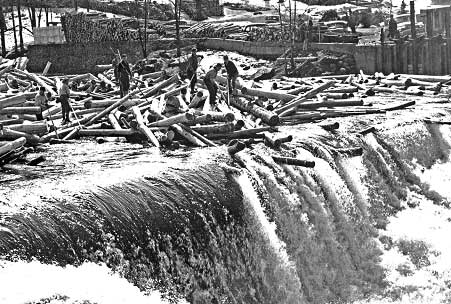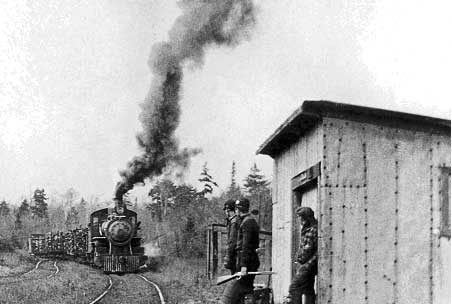Tug Hill Storytelling: I was fortunate to know Matthew Joseph “Joe” Conway. Joe, a native of the Tug Hill region of New York

A Look Back In Time
Tug Hill Storytelling: Tales of Prosperity and Snowstorms
An article printed in “The Northern Logger “, Sept.. 2021
In the fall of 1977, I sat among former lumbermen at Joe and Madge Conway’s home in Woodgate, New York. I was there to attend story-telling sessions about the old days held at the Conway home. I was fortunate to know Matthew Joseph “Joe” Conway. Joe, a native of the Tug Hill region of New York, was born in Highmarket and grew up in Port Leyden, a logging community, surrounded by old- timers and characters who ran the gamut of trades. Loggers and lumberjacks – actually anything related to the old days of the logging industry – were his favorite hobby because he related to the forest and the people who used to call it home.
At the Conway house, I heard a lot of bragging about the old days, but these stories were also a proud reflection of the men’s local history. There may have been a bit of grandstanding …did anyone really believe the story about a logger darting from a bank, jumped into a river with a loud splash, and began racing across the surface on nimble feet, with only his speed and a fringe of scales on the sides of his webbed toes keeping him from sinking?
Maybe not, but it didn’t matter. Joe’s confab sessions with old-time loggers were a sensation. He was witty and always colorful. I was invited to attend evening gatherings with Lyons Falls, N.Y. Gould Paper Company factory employees, former ’jacks, river drivers, road monkeys, men who were part of loading crews, Linn tractor drivers, and other hard-working, brave and trustworthy men-of-the-woods who had been involved in the operation of lumber camps and various logging operations. The diverse crowd was much like the multi-hued outburst of fall color outside Joe’s living room. Autumn was the time we typically gathered. Unfortunately, as I think back, I wish I’d had the foresight to bring a tape recorder. I could have captured and preserved a way of life that has now vanished from the scene. At least I took notes.
Joe told me he hoped the informal chit- chat would “provide me a with a review of life in the Adirondack woods before that which is hailed today as ‘progress’ had had its effects. And, perhaps, it would provide a chuckle or two and much nostalgia.” He always concerned himself with those personal stories: During Joe’s retirement years, he turned his hand to writing regional history. He has passed on, but I have my memories and his two books Highmarket As You Were: Two Hundred Years of Tug Hill (self-published, 1977) and Port Leyden, The Iron City: A Passing Glance (self-published, 1989). Wanting to preserve as much as possible about life in the once-flourishing community of Tug Hill, he collected historical facts, maps, newspaper files, church records, and census reports, gathered family stories and pictures, and interviewed long-time natives. His personal approach to telling a story is just the opposite of how formal county histories read. He opened Highmarket As You Were by quoting Tom O’Brien’s one-page book titled Short History of Highmarket. O’Brien was an old-time Tug Hill native who Conway said wrote “brusquely, simply, and factually.”

A log-loaded Glenfield-Western “Gee-wiz” train approaches John Alger, Henry Gremo, and Henry Sattler waiting at a Tug Hill whistle stop.
COURTESY JOANNE SATTLER
This is Tom O’Brien’s entire book:
First the Indians settled there;
And the Yankees drove them out.
Next, the Welsh, Irish, and Dutch
drove the Yankees out.
Then the Polacks drove the Welsh,
Irish, and Dutch out.
Now the woodchucks are drivin’ the
Polacks out.
Conway commented that wit of the Irishman “accurately establishes the migratory order of the various nationalities who ‘Came, Saw,’ only to be eventually ‘conquered’ by the elements and changing times. Possibly the woodchucks were there all the time.”
Following the Iroquois, who as their Native American legend tells “sprang from the ground” somewhere in the vicinity of Barnes Corners, white pioneer settlers arrived. Conway states that 1814 marked the year pioneering folks made “a long arduous trip by ox cart from Connecticut up into this desolate Lesser Wilderness” (the term distinguishes Tug Hill from the Adirondacks, the “Greater Wilderness” ). The pioneers stayed, erected rough log cabins, and began clearing plots of the forest around their shelters for crops. This was the beginning of Thompson Corners, soon-to-be renamed Highmarket, Joe Conway’s ancestral home.
Today, Highmarket exists only as a name on a map. Around 1849 the Irish began to move in after they had built the Black River Canal, and soon after the Welsh, Germans, and Swiss followed. It was this pioneer era that gave way to progress. Conway wrote: “At the tender age of eleven or twelve, many [boys began to] learn the lumberjack trade first-hand” and opportunities for most girls were just as unfortunate. Some worked at home, became housemaids in surrounding towns, “or went to Utica to work in the textile mills.” Conway knew of one girl who began cooking in a lumber camp at the age of twelve, “progressing at sixteen to the same occupation on a state barge which traveled between Lyons Falls and Carthage.”
The abundance of timber brought a level of material prosperity to early Tug Hill residents.
Conway writes: “It has been recorded that between 1840 and 1860, Lewis County furnished about two-thirds of all birdseye maple used in the world, with most of this coming from the Tug Hill Plateau. The tall spruce of the plateau were in great demand for spars for the sailing vessels of the day as were the sawed softwoods for city wharves, piers and buildings. New York City and Buffalo used tremendous amounts of Tug Hill timber for their wharves and docks.
Both timber and spars were being shipped out of Highmarket as early as 1856, drawn by teams to Port Leyden and Boonville, where the spars were bound into rafts and towed down the Black River to the Erie [Canal] and beyond. Both the canal boats and the Black River Railroad transported the sawed lumber…”
Think of all the oyster kegs, barrels, cheese tubs, butter firkins, wagon tongues, flooring, pianos, spars, piles, wharves, piers, newsprint, paper bags, toilet tissue, boxes, cartons, writing paper, charcoal, alcohol, and buildings that Tug Hill timber provided. And the little town of Highmarket was a big contributor ….
Joe Conway’s brief discussion of logging reflects the industrialism and shows the true pioneer spirit that was necessary for those early lumbermen and women to settle and eke a living in the upland country known for 400-inch snow sea- sons. As one descendant remarked to Joe about those who endured the lofty plateau, “They all should have flags on their graves — just for fightin’ the Tug Hill snowstorms.”
Unfortunately, by the time Joe began gathering materials and published Highmarket, As You Were, it was too late for many personal stories. Those who could have related happenings on The Hill were gone.

Conway told of whitewater crews as “men of steel. Driving logs was no child’s game.” A force of water and logs. These grim battles relied on the ingeniousness and courage.
JIM FYNMORE COURTESY LYONS FALLS HISTORY ASSOCIATION